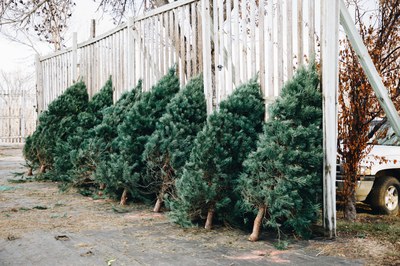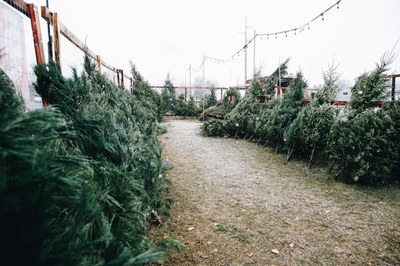Real vs. Artificial: Which Tree is Better?
 For many families, it is a tradition to find “the one” during the holiday season, cutting down a tree themselves, and making a lifelong memory for their children. This was on my mind as we decorated our Christmas tree this year, with my two year old daughter helping us for the first time. Ours is a six foot, gold, artificial tree that I purchased on sale right after I graduated college. It doesn’t have the wonderful smells and experience like a real tree, but we like the convenience to box it up, with minimal clean-up, and trust it will be the same next holiday season. Consumers are becoming more aware of their purchases’ environmental impacts, and many wonder what kind of Christmas tree is the most sustainable. Here are some things to consider.
For many families, it is a tradition to find “the one” during the holiday season, cutting down a tree themselves, and making a lifelong memory for their children. This was on my mind as we decorated our Christmas tree this year, with my two year old daughter helping us for the first time. Ours is a six foot, gold, artificial tree that I purchased on sale right after I graduated college. It doesn’t have the wonderful smells and experience like a real tree, but we like the convenience to box it up, with minimal clean-up, and trust it will be the same next holiday season. Consumers are becoming more aware of their purchases’ environmental impacts, and many wonder what kind of Christmas tree is the most sustainable. Here are some things to consider.
Artificial trees have the convenience and consistency that many consumers prefer. Affordability is another factor that people take into consideration; one purchase spread out over multiple years ends up being more cost-effective in the long run. Many artificial trees do get used for many seasons. One 2018 study determined that artificial trees may have less of an environmental impact if they are reused for at least five years, compared to buying a new real tree each year. Another study argued that they would only become better than natural ones if used for 20 years. However, no matter how many years it has been reused, once these trees are no longer of use, these trees and the plastics with which they are made end up in landfills.
Real trees, on the other hand, don’t require the intensive carbon emissions that it takes to produce and ship artificial trees. Living trees actually sequester—or absorb— carbon dioxide from the air and release oxygen. It can take six or seven years to grow a Christmas tree to its typical height to sell commercially. In that time, those trees are also providing ecological services to the environment around them, such as preventing erosion, improving water quality, and serving as habitat for wildlife. Real trees can be repurposed in many ways that artificial trees cannot. Many communities collect trees after the holidays and turn them into mulch, which is then used to protect other living trees and add to soil health.
When our forests are managed sustainably, they can make renewable resources like Christmas trees and other forest products. Many people cringe when they think of trees being cut down, but rest assured, for every tree that is harvested on a tree farm, one to three seedlings are planted in its place. And in many cases, these tree farms are family-owned operations. There are about 14 tree farms in North Dakota, and other real tree sellers in the state source from Minnesota and Wisconsin. By supporting local farmers, you’re helping them maintain healthy forests for generations to come while also supporting the local and regional economy.
I know I will continue using my artificial tree until my carbon footprint for it gets closer to zero. At that point, we may decide to switch to real trees. I adore the smell of a fresh Frasier fir, and I hope to teach my daughter about why we shop local, support our tree farmers, and think about the environment when it comes to making purchases.
By Beth Hill, Outreach and Education Manager, North Dakota Forest Service



